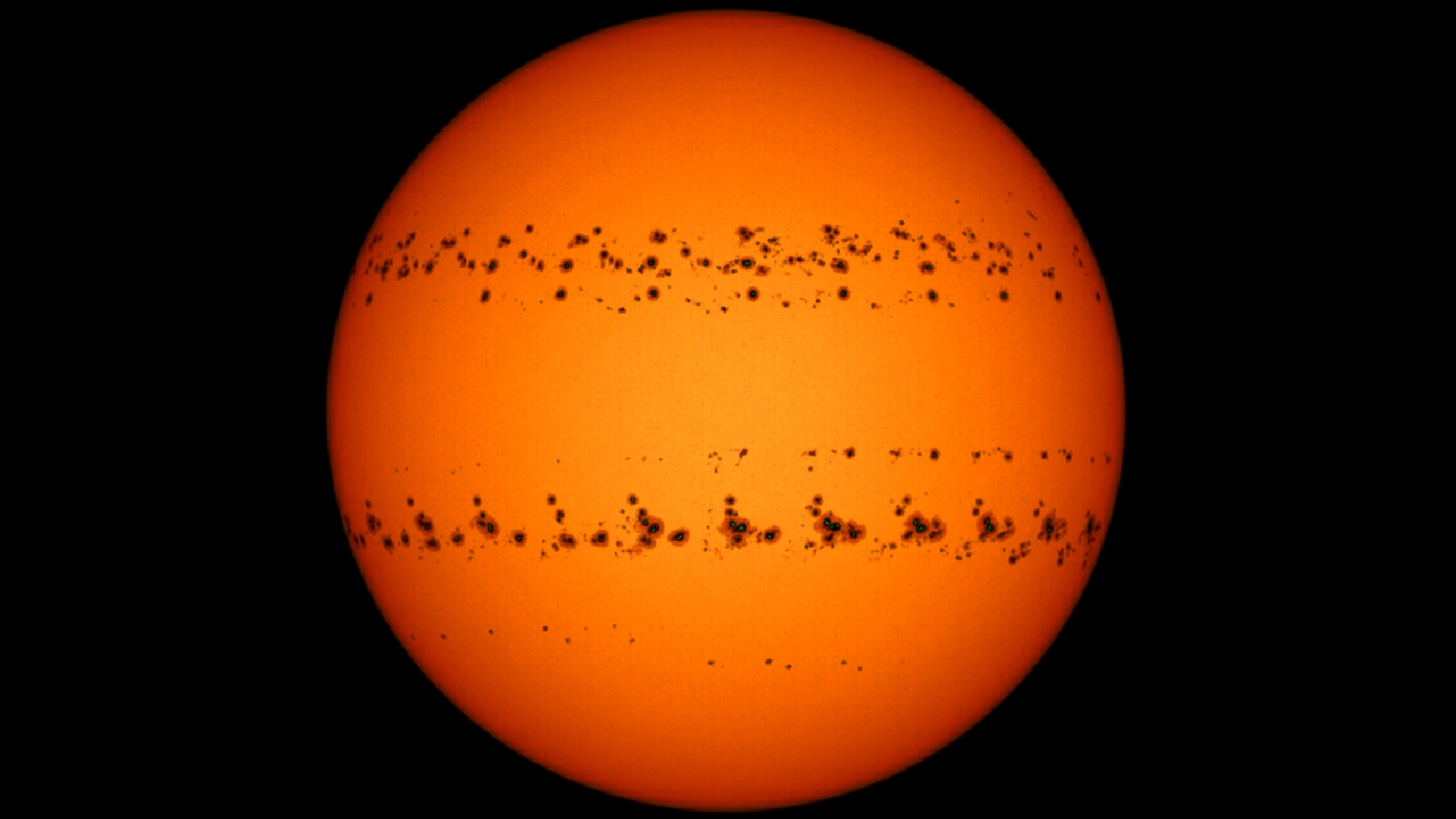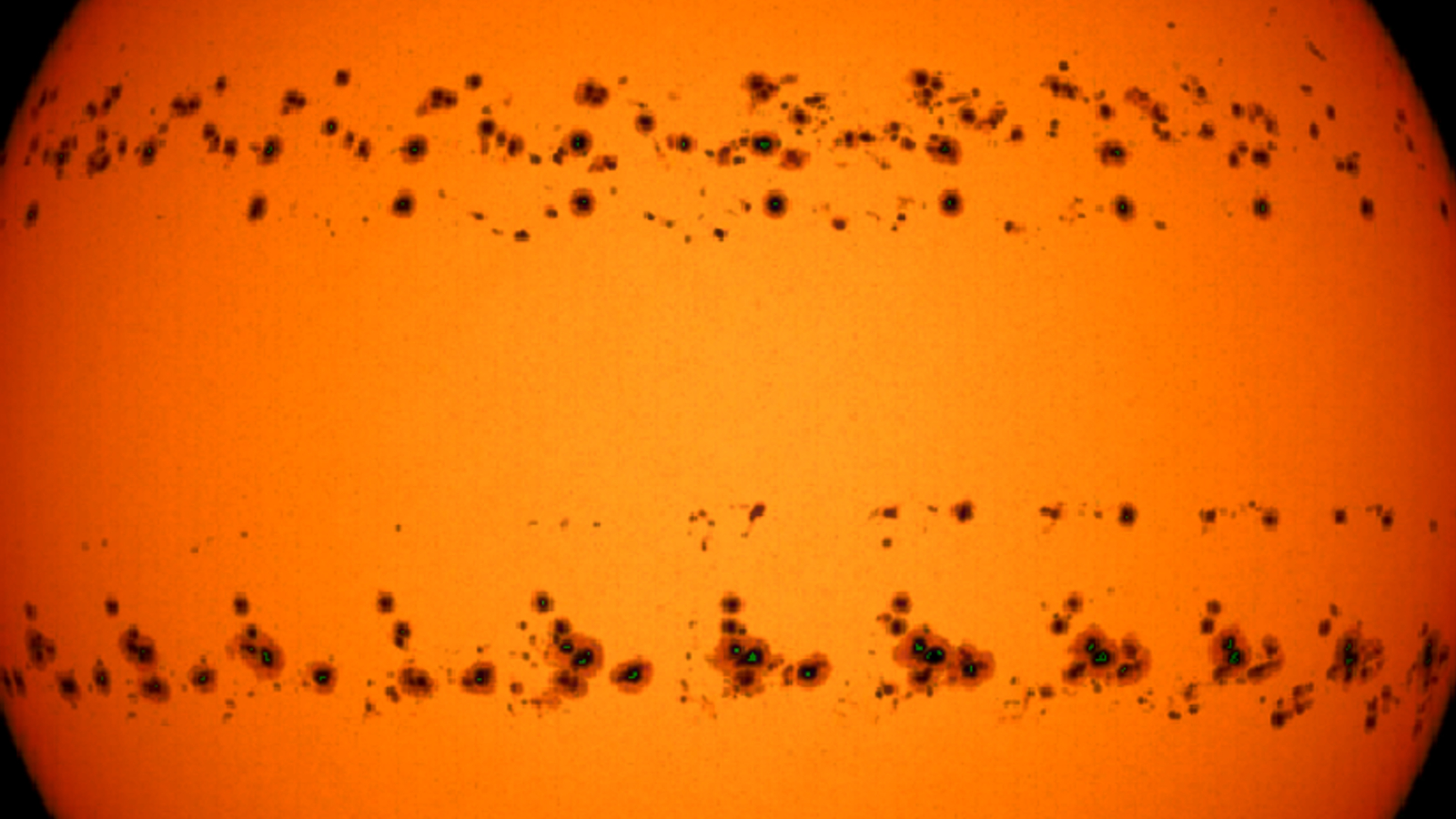Incredible time-lapse photo captures the sun during an 8-year sunspot peak

A stunning new time-lapse photo shows two bands of shape-shifting sunspots moving across the sun's surface as our host star spins at the center of the solar system. When the mesmerizing image was captured, the total number of sunspots was at its highest in eight years, suggesting that solar activity is about to ramp up another notch.
Şenol Şanlı, an amateur astrophotographer based in Bursa, Turkey, created the new image using data from NASA's Solar Dynamics Observatory. The photo, which Şanlı shared on his Instagram account on Jan. 3, is a composite of individual snaps taken between Dec. 2 and Dec. 27, 2022. The two bands of evolving clusters in the image belong to a pair of particularly large sunspot groups: A3176, located to the north of the sun's equator; and A3153, in the sun's southern hemisphere, both of which moved from east to west (right to left in the image). Şanlı digitally removed other visible sunspots on the sun's surface from this period, allowing the observer to track the minute changes in the sunspot groups over time.
Related: Can sunspots affect the weather?


Want to get a better look at the moon? We recommend the Celestron Astro Fi 102as the top pick in our best beginner's telescope guide. Don't forget a moon filter if you'll be looking towards our celestial companion.
Sunspots are planet-size regions of the sun's visible surface, or photosphere, with increased magnetic fields. The spots are not actually black; they appear darker than the rest of the photosphere because they are much cooler than their surroundings. Scientists track these regions of strong magnetism because they can spit out potentially disruptive solar flares and coronal mass ejections (CMEs).
During December 2022, more than 113 sunspots were detected on the sun's surface — the most since December 2014, according to the National Oceanic and Atmospheric Administration's Space Weather Prediction Center. This total is a considerable increase compared with the rest of 2022, which had an average of 73.3 sunspots each month prior to December.
The sunspot increase is a result of the sun entering the more active phase of its 11-year solar cycle, which should peak in 2025. In 2022, scientists measured an increase in the frequency and strength of solar storms, and 2023 will likely be even more active if the number of sunspots remains high or increases further.
Several major solar storms have already erupted this year. On Jan. 3, a suspected X-class solar flare, the most powerful type of flare the sun can produce, exploded on the far side of the sun. Just three days later, the sun belched out a confirmed X-class flare from the same sunspot. And on Jan. 4, Earth's magnetic field was bashed by a potentially disruptive CME right as the planet reached its closest point to the sun, known as perihelion.
Get the Space.com Newsletter
Breaking space news, the latest updates on rocket launches, skywatching events and more!
Originally published on LiveScience.com.
Join our Space Forums to keep talking space on the latest missions, night sky and more! And if you have a news tip, correction or comment, let us know at: community@space.com.

Harry is a U.K.-based staff writer at Live Science. He studied Marine Biology at the University of Exeter (Penryn campus) and after graduating started his own blog site "Marine Madness," which he continues to run with other ocean enthusiasts. He is also interested in evolution, climate change, robots, space exploration, environmental conservation and anything that's been fossilized. When not at work he can be found watching sci-fi films, playing old Pokemon games or running (probably slower than he'd like).
-
Helio That was quite a group of sunspots last month. There are about 6 groups on the Sun now.Reply
For fun, here is what the Sun would actually look like today if you were in space and used an attenuation device to reduce the enormous intensity of the Sun to something within your eye's range:










